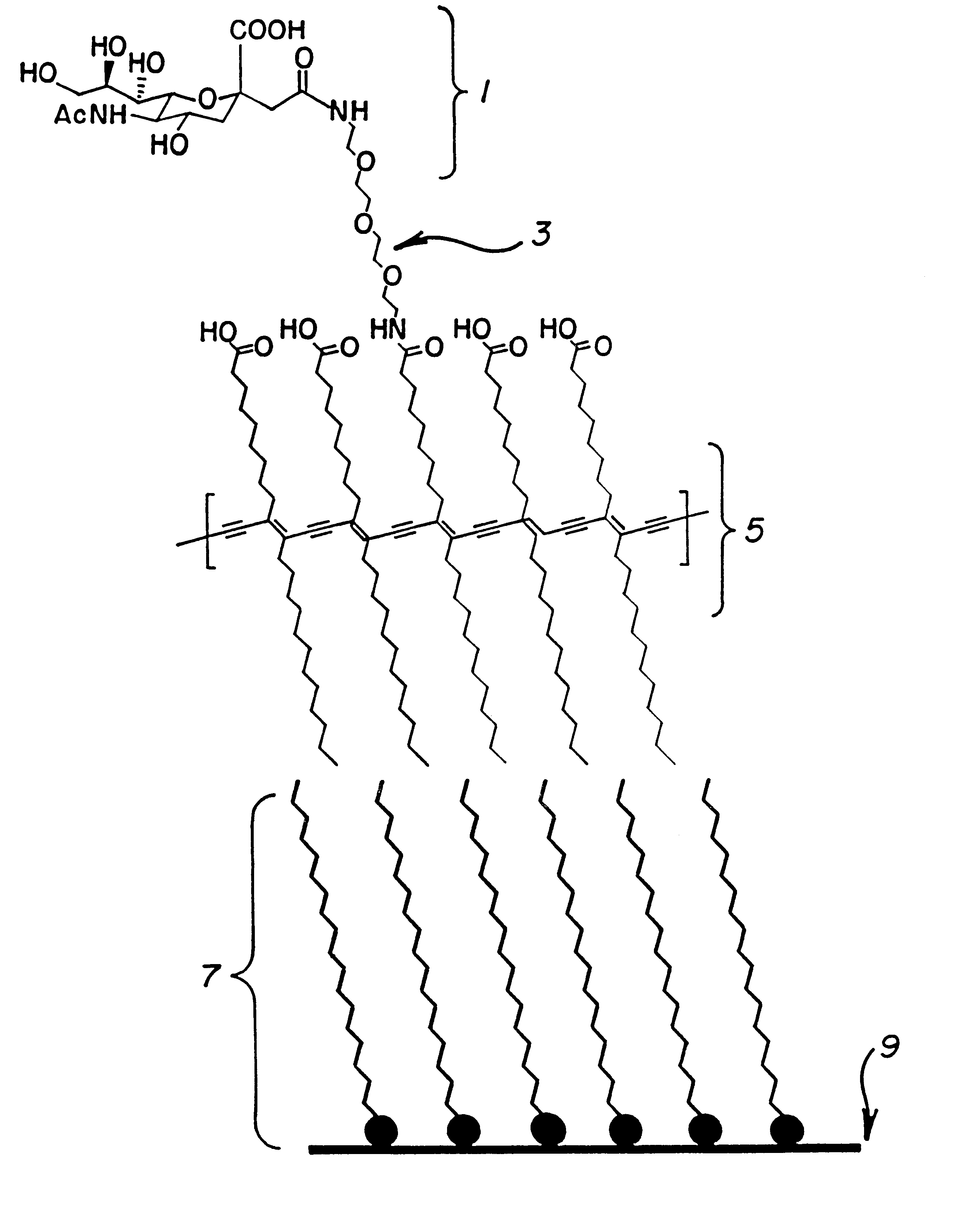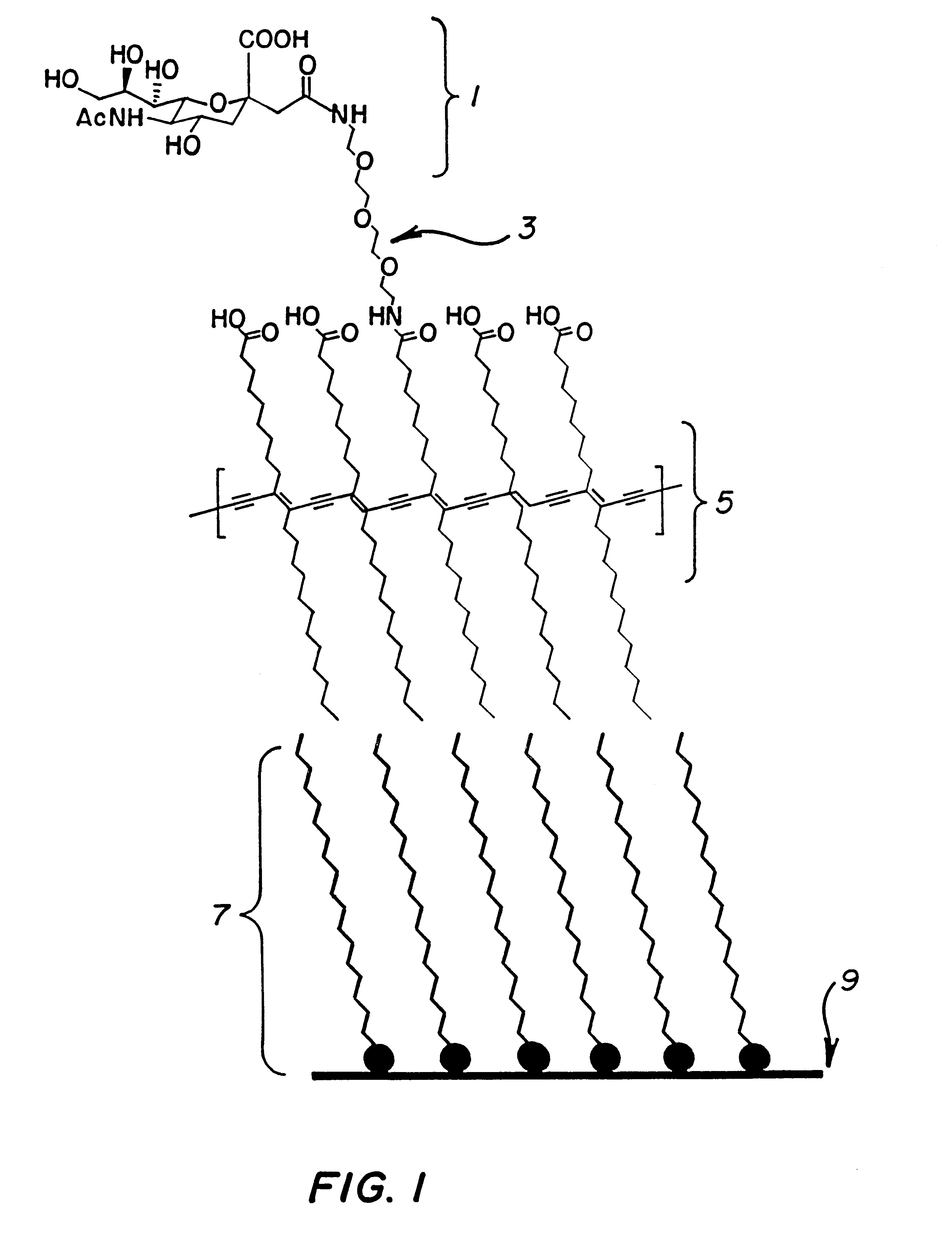Polymeric assay film for direct colorimetric detection
a colorimetric and assay film technology, applied in the field of polymeric assay film for direct colorimetric detection, can solve the problems of limited or no practical application of analytical chemistry methods to many biological parameters, large quantities of analytes are generally required, and limited quantitative results are limited or not available, so as to achieve limited applicability, low cost, and high genetic conservation over time
- Summary
- Abstract
- Description
- Claims
- Application Information
AI Technical Summary
Benefits of technology
Problems solved by technology
Method used
Image
Examples
example 1
Detection of Influenza Virus
The inventive diacetylenic lipid monomers such as compound 1 (FIG. 1) are readily polymerized in monolayers by ultraviolet irradiation to form a conjugated polydiacetylene backbone of alternating eneyne groups using standard art methods (Ticke, et al., Colloid Polymere Science, Vol. 255, p. 36, 1977, and Day, et al., Journal of Polymer Science, Letters to the Editor, Vol. 16, p. 205, 1978.
In one embodiment of the subject invention, the inventors have developed a polymerized bilayer assembly shown in FIG. 1 composed of a self-assembled monolayer of octadecyltrichlorosilane (OTS) and a LB monolayer of functionalized polydiacetylene.
The inventive LB film was designed to undergo color, transition from blue to red solely due to receptor-ligand interactions occurring at the surface of the bilayer. Therefore, the bilayer assembly incorporates both a molecular recognition site and a detection element. This simple color-based sensor enables rapid, qualitative dete...
example 2
Drug Development
A receptor and its reciprocal binding partner (receptor-binding molecule) known to be involved in the physiological regulation of interest are selected. The binding partner is incorporated into the inventive film. In the case of neurotransmission and neurological drug development, for instance, a dopamine receptor can be employed. In the case of drug development toward pathogens such as influenza, for instance, the viruses hemagglutinin receptor can be employed. The binding partner incorporated into the film is dopamine (or a dopamine analog) or sialic acid (or sialic acid analog), respectively. The goal of the drug in the case of hormones and neurotransmitters is to interact with the binding site in a way which effects physiological functions.
If the described receptor is present, it will cause a color change when allowed to bind to the inventive membrane incorporating the binding partner. The receptor can be present in the form of cell membranes from tissues incorpo...
example 3
Generalized Approach
Generic films can be made where the binding partner can be kept constant and an intermediate linking moiety can be varied to accommodate an ancillary novel binding partner. As an example, a film which has biotin on its surface binds the protein streptavidin. This protein is tetravalent, therefore in its bound state it still has one or more sites available for biotin binding. Novel binding partners need only be derivatized with biotin to attach themselves to the film surface (through the intermediacy of the streptavidin protein). Only a single biotinylated film is prepared, and built up in a sandwich fashion with streptavidin then the biotinylated test binding partner. Exposure of this assembly to the test receptor gives the desired color change. As in the previous example competitive assays are performed to identify new drug candidates.
PUM
 Login to View More
Login to View More Abstract
Description
Claims
Application Information
 Login to View More
Login to View More - R&D
- Intellectual Property
- Life Sciences
- Materials
- Tech Scout
- Unparalleled Data Quality
- Higher Quality Content
- 60% Fewer Hallucinations
Browse by: Latest US Patents, China's latest patents, Technical Efficacy Thesaurus, Application Domain, Technology Topic, Popular Technical Reports.
© 2025 PatSnap. All rights reserved.Legal|Privacy policy|Modern Slavery Act Transparency Statement|Sitemap|About US| Contact US: help@patsnap.com



